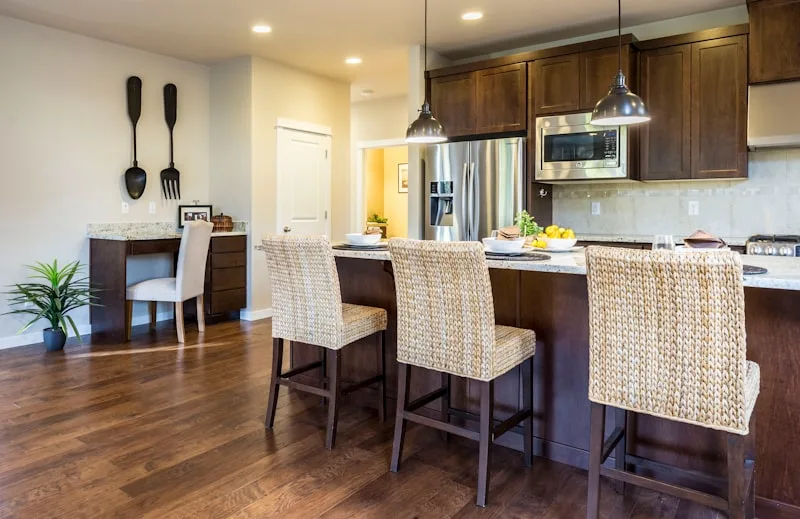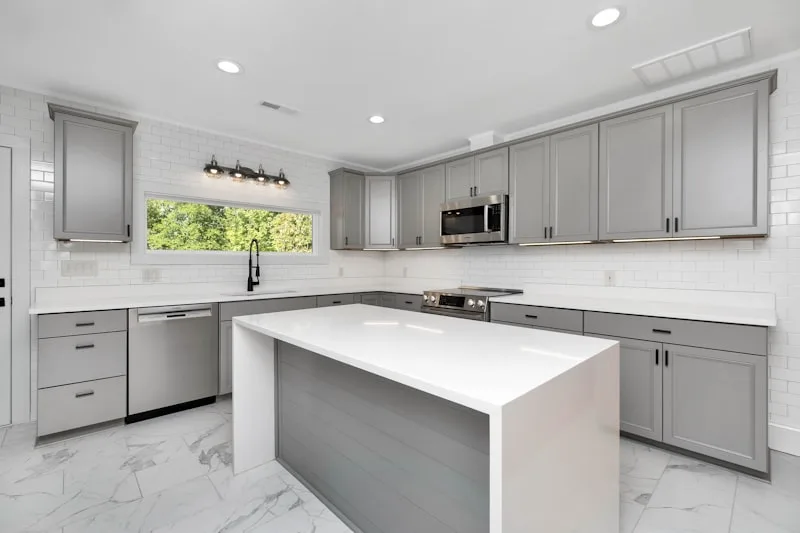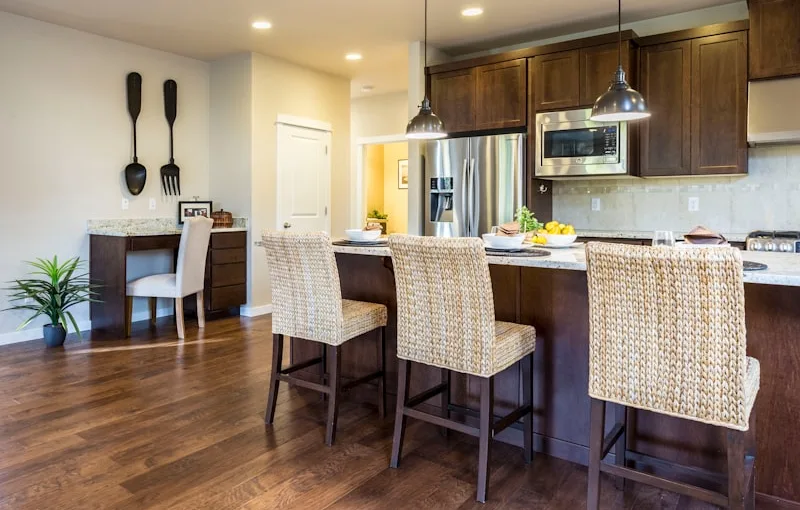The kitchen cabinet was created out of necessity. As people began to cook more elaborate meals, they needed a way to store their ingredients and tools efficiently. Imagine trying to whip up a gourmet dinner with flour flying everywhere and utensils lost in the shuffle! Kitchen cabinets stepped in like a superhero, providing a designated space for everything from spices to silverware.
But it wasn’t just about tidiness. These cabinets also served a practical purpose. They helped keep food safe from pests and moisture, which was crucial in the days before refrigeration. Think of them as the original food vaults, protecting your culinary treasures. Plus, they made it easier to access what you needed while cooking, saving time and reducing frustration.
Over the years, kitchen cabinets evolved from simple wooden boxes to stylish, functional pieces of furniture. They became a canvas for creativity, allowing homeowners to express their personal style. Whether you prefer sleek modern designs or rustic charm, there’s a cabinet out there that fits your vibe.
From Storage to Style: The Evolution of the Kitchen Cabinet
Picture this: centuries ago, kitchens were all about function. Cabinets were simple, utilitarian boxes, often hidden away in dark corners. Fast forward to today, and they’ve transformed into the heart of kitchen design. It’s like watching a caterpillar turn into a butterfly! Now, cabinets come in a dazzling array of styles, colors, and materials, each telling a story about our tastes and lifestyles.
Ever noticed how open shelving has become all the rage? It’s like inviting your favorite dishes to a party! Instead of hiding everything behind closed doors, we’re showcasing our beautiful dishware and spices, adding a personal touch to our kitchens. And let’s not forget about the rise of smart cabinets. Imagine a cabinet that knows exactly where your favorite frying pan is hiding—talk about a game changer!
But it’s not just about looks; it’s about functionality too. Modern cabinets are designed with clever storage solutions that maximize space. Think pull-out shelves, lazy Susans, and hidden compartments. It’s like having a magician in your kitchen, making clutter disappear!
So, whether you’re a minimalist who loves sleek lines or a maximalist who adores bold colors, kitchen cabinets have evolved to reflect your personality. They’re no longer just storage; they’re a canvas for creativity, a blend of art and practicality that makes cooking a joy. Isn’t it fascinating how something so simple can have such a profound impact on our daily lives?
The Kitchen Cabinet: A Historical Perspective on Culinary Organization
Historically, kitchen cabinets have evolved from simple wooden shelves to intricate designs that reflect the culture and technology of their time. In the 18th century, for instance, cabinets were often handcrafted, showcasing the artisan’s skill. They weren’t just functional; they were a statement of wealth and style. Picture a grand estate with a beautifully carved cabinet, filled with fine china and spices, a true centerpiece of culinary pride.

Fast forward to the 20th century, and you’ll see a shift towards practicality. With the rise of modern appliances and the need for efficiency, kitchen cabinets became more streamlined. They transformed into the organized sanctuaries we know today, designed to maximize space and minimize clutter. Think of them as the unsung heroes of the kitchen, quietly holding everything together while we whip up our favorite meals.
But it’s not just about looks; the kitchen cabinet has played a crucial role in how we approach cooking. It’s like a treasure chest, holding the tools and ingredients that inspire our culinary adventures. From spices that transport us to distant lands to utensils that help us create masterpieces, these cabinets are the backbone of our cooking experiences.
Why Every Home Needs a Kitchen Cabinet: Unpacking Its Purpose and Design

Imagine your kitchen without cabinets. It would be like a book without pages—chaotic and incomplete. Kitchen cabinets are not just about storage; they’re about creating a functional and inviting environment. They keep your pots, pans, and spices organized, making it easy to whip up your favorite dish without a scavenger hunt. Plus, they help declutter your countertops, giving you more space to work your culinary magic.
But let’s talk design. Kitchen cabinets come in a variety of styles, colors, and materials, allowing you to express your personality. Whether you’re into sleek modern lines or rustic charm, there’s a cabinet style that can transform your kitchen into a masterpiece. Think of them as the wardrobe of your kitchen—just like you wouldn’t wear mismatched clothes, you wouldn’t want your kitchen to look disjointed.
And let’s not forget about the impact on home value. A well-designed kitchen with quality cabinets can significantly boost your home’s appeal. It’s like putting a cherry on top of a sundae; it makes everything look more delicious!
So, why does every home need a kitchen cabinet? Because they’re more than just storage; they’re a blend of functionality and style that enhances your cooking experience and elevates your home’s aesthetic. In a world where first impressions matter, your kitchen cabinets are the welcoming smile that invites everyone in.
The Birth of the Kitchen Cabinet: How Functionality Shaped Culinary Spaces
Back in the day, kitchens were often chaotic, with utensils scattered about like confetti after a party. But as cooking evolved from a basic necessity to an art form, so did the need for organization. Enter the kitchen cabinet—a game changer! Think of it as the superhero of the kitchen, swooping in to save the day by providing a designated space for everything.
The design of kitchen cabinets has come a long way. Early cabinets were simple wooden boxes, but as culinary needs grew, so did the complexity of these storage solutions. They became more than just functional; they morphed into stylish statements that reflect personal taste. It’s like dressing your kitchen in its Sunday best!
Functionality played a crucial role in this evolution. With the rise of modern appliances and cooking techniques, cabinets adapted to accommodate everything from blenders to baking sheets. Imagine trying to whip up a gourmet meal without a place to store your gadgets—chaos, right? Cabinets not only keep things tidy but also make cooking more efficient, allowing chefs to focus on what they do best: creating delicious dishes.
Beyond Storage: The Kitchen Cabinet’s Role in Domestic Life Through the Ages
Back in the day, kitchens were often just a hearth with a few shelves. Fast forward to the Renaissance, and cabinets became symbols of wealth and status, showcasing fine china and elaborate spices. They weren’t just for storage; they were a way to flaunt your culinary prowess and social standing. Can you picture a grand dinner party where the host opens a beautifully crafted cabinet to reveal a stunning array of dishes? It’s like unveiling a treasure chest!
As time marched on, the role of kitchen cabinets evolved yet again. In the 20th century, with the rise of modernism, cabinets became sleek and functional, reflecting a shift towards efficiency in cooking. They started to embody the idea that the kitchen is the heart of the home, a place where families gather, share stories, and create memories. Think about it: how many family recipes have been passed down while rummaging through those cabinets?
Frequently Asked Questions
What purpose do kitchen cabinets serve in modern kitchens?
Kitchen cabinets are essential for organizing and storing kitchen items, providing easy access to utensils, cookware, and food supplies. They enhance the kitchen’s functionality and aesthetics, offering a designated space for everything while contributing to the overall design and style of the kitchen.
How do kitchen cabinets enhance kitchen organization and functionality?
Kitchen cabinets play a crucial role in enhancing organization and functionality by providing designated storage spaces for utensils, cookware, and pantry items. They help declutter countertops, making the kitchen more efficient for cooking and meal preparation. With various styles and configurations, cabinets can be tailored to fit specific needs, ensuring easy access to frequently used items and maximizing available space.
How have kitchen cabinets evolved over time?
Kitchen cabinets have transformed significantly from simple wooden structures to sophisticated, multifunctional storage solutions. Initially designed for utility, modern cabinets now incorporate advanced materials, innovative designs, and customizable features, reflecting changing lifestyles and aesthetic preferences. This evolution has enhanced both the functionality and visual appeal of kitchens.
What is the history behind the creation of kitchen cabinets?
The evolution of kitchen cabinets dates back to ancient civilizations, where storage solutions were primarily functional. In the 18th century, the rise of the middle class and advancements in woodworking led to more decorative and practical designs. By the 20th century, mass production and modern materials transformed kitchen cabinets into essential components of home design, focusing on both aesthetics and efficiency.
What materials are commonly used in kitchen cabinet construction?
Common materials for kitchen cabinet construction include plywood, particleboard, medium-density fiberboard (MDF), and solid wood. Plywood is durable and resistant to warping, while particleboard and MDF are cost-effective options that provide a smooth surface for finishes. Solid wood offers a classic look and longevity but can be more expensive. Each material has its own benefits, making it important to choose based on budget, style, and durability needs.
